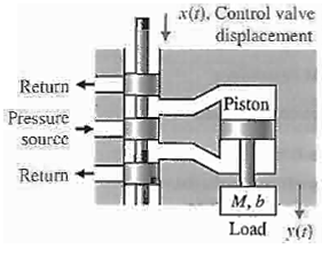Transfer Function Of A Hydraulic Actuator
Transfer function of a hydraulic actuator:

Fig: 1 Hydraulic actuator
A hydraulic actuator is capable of providing a large power amplification. It will be assumed that the hydraulic fluid is available from a constant pressure source and that the compressibility of the fluid is negligible. A downward input displacement x moves the control valve; thus, fluid passes into the upper part of the cylinder, and the piston is forced downward. A small, low power displacement of x(t) causes a larger, high-power displacement, y(t). The volumetric fluid flow rate Q is related to the input displacement x(t) and the differential pressure across the piston as Q = g(x, P). Using the Taylor series, we have

where g = g(x, P) and (x0, PQ) is the operating point. The force developed by the actuator piston is equal to the area of the piston, A, multiplied by the pressure, P. This force is applied to the mass, so we have

Rearranging the above equation we have,

Therefore, using the Laplace transformation, we have the transfer function

Note that the transfer function of the hydraulic actuator is similar to that of the electric motor. For an actuator operating at high pressure levels and requiring a rapid response of the load, we must account for the effect of the compressibility of the fluid.